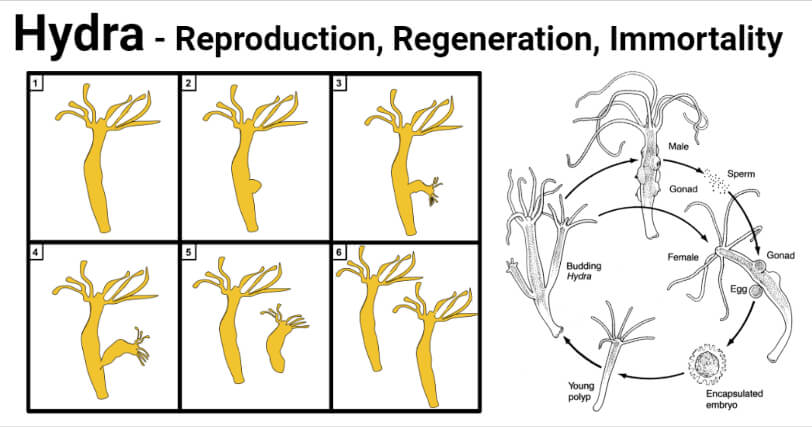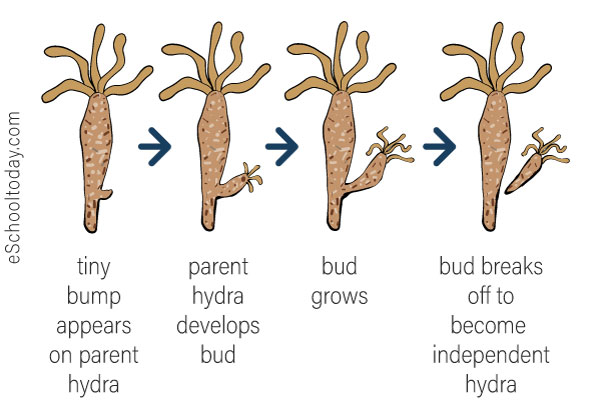Budding and Regeneration Share Which of the Following Characteristics
Organisms such as Hydra and Yeast undergo budding for their reproduction purpose. The answer is option B plasmodium.

Hydra Reproduction Budding And Sexual Regeneration Immortality
Budding is a mode of asexual reproduction seen in Hydra.

. Meiosis is a type of cell division that reduces the number of chromosomes in the parent cell by half and produces four gamete cells. Results show that regeneration and fission share numerous sometimes exclusive developmental processes but also present a number of differences spread out. Regenerative ability in such organisms correlates closely with their capacity to reproduce asexually most commonly by fission or by budding and the mechanisms of growth involved in regeneration are often very similar to those of asexual propagation.
Reproduction is a biological process. Wiki User 2017-02-22 164218. A Only 1 correct.
Planting a cutting from a potato to grow a new potato plant. Which of the following methods should be used. Flat worms pqrstu1babbac2ccbaac3cacbba4bbccaa Practice questions MCQs Past Year Questions PYQs NCERT Questions Question Bank Class 11 and Class 12 Questions NCERT Exemplar.
Which of the following does not reproduce by binary fission. A Larvae are ciliated and swim to new locations. What is the difference.
C Both 1 and 2 correct. The process is done by producing buds in the body wall. Bees bringing pollen from the flower of one plant to the flower of an another.
Severed body parts can be redeveloped or a body part can develop into complete body therefore it is a type of asexual reproduction. Only certain damaged tissues can be regenerated ii Restorative regeneration. Reproduction in Organisms Class 12 Questions and Answers PDF Download.
Regeneration is of two types. For Hydra this is the most common mode of reproduction and occurs under favorable environmental conditions. Hydra reproduce asexually through a process known as budding.
D Only 3 correct. This process is required to produce egg and sperm cells for sexual reproduction. We hope you liked the above provided MCQ Questions Chapter 1 The Living World Class 11 Biology with solutions.
21 Which of the following statements about sponges is NOT correct. Cross-pollinating this crop with another good variety and growing the seeds resulting from the cross A. B Only 2 correct.
B Sponges are classified by spicule type and material. This is because the specialized cells present in the organism can differentiate and grow into a new individual. Which among the following organism that reproduces by budding.
The offspring of a budding organism starts as an. When the food is plentiful the asexual reproduction occurs in hydra. Which of the following reproduces by budding.
Describe the characteristics that all animals share. In some species buds may be produced from almost any point of the body but in many cases budding is restricted to specialized areas. The initial protuberance of proliferating cytoplasm or cells the bud eventually develops into an.
Reproduction enables the continuity of the species generation after generation. For example some crabs can grow new claws or body parts after the original parts are lost. 7 6 Explain how you could use a number line to find the difference.
A plant that grows a bud and eventually falls off that looks exactly like the parent. Hydra is an organism that reproduces by budding. Budding is the process of producing an individual through the buds that develop on the parent body.
There is a cycle of birth growth and death. Write a subtraction equation with a difference of 5457. During budding a small bud develops near the basal part of the parent Hydra through repeated mitotic division of the epidermal interstitial cells.
Simple organisms are more successful with regeneration than complex organisms. Sexual reproduction involves meiosis in the formation of gametes. Budding in biology a form of asexual reproduction in which a new individual develops from some generative anatomical point of the parent organism.
Organisms like hydra and planaria exhibit regeneration. Regeneration of lost body parts occurs mostly in invertebrates. Hydra is a small freshwater organism.
Regeneration and budding in worms. An orchid with a flower structure that forces self-pollination. Growing seeds produced from this variety D.
Which of the following is a characteristic of an annelid a nephridia b closed circulatory system. They are native to temperate and tropical regions. All animals share the following characteristic a.
If you have any questions please ask us in the comments box below. C Sponges comprise a sister group to all other animals. Both are exclusive.
Not having cell nuclei b. Hydra can reproduce by the process of regeneration and budding. Then draw a number line to show between which two whole numbers the difference lies.
Regeneration in asexual reproduction is the ability of a simple organism to re-grow its lost parts. Budding and regeneration are asexual methods of reproduction. Having cell walls d.
Sponges may reproduce asexually by budding or by regeneration from a small piece. Flat worms pqrstu1babbac2ccbaac3cacbba4bbccaa The Living World Botany Practice questions MCQs Past Year Questions PYQs NCERT Questions Question Bank Class 11 and Class 12. The correct answer is 3 ie.
Being a consumer c.

Sexual And Asexual Reproduction Study Guide Inspirit

Budding Fragmentation Regeneration Spores Video Khan Academy

Hydra Reproduction Budding And Sexual Regeneration Immortality
Comments
Post a Comment